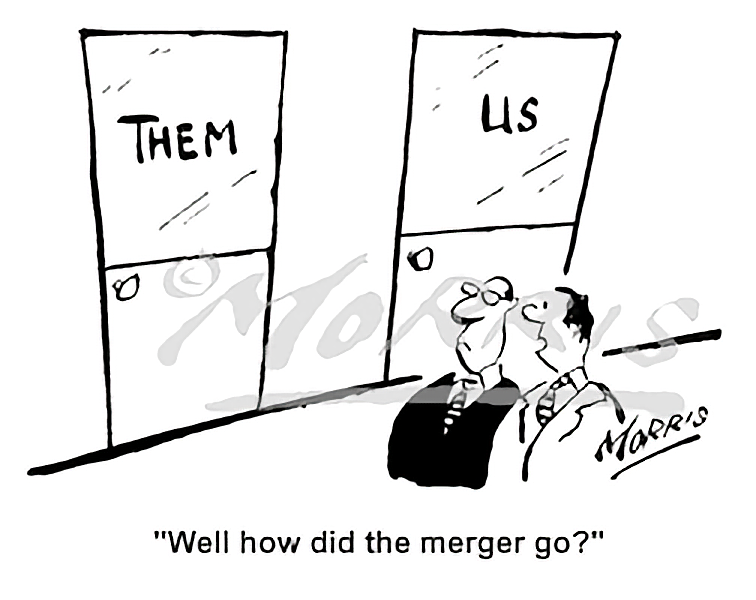Getting Hitched: An Introduction to Mergers
Initial Considerations
First Steps
Mission and Vision
Leadership
Public Perception
Coming to Terms
How to Operate
Merger Alternatives
Economic uncertainty, strategic necessity, business opportunity, mission motivation: the driving forces behind mergers have always simmered but for many the moment has come. Nonprofit funders and thought leaders are now vocal proponents.
Plan A’s eight-part series offers guidance for the process. In our first segment, we outline some of the rationales for considering a merger.
Initial Considerations

“Nicholas Hobart”
Merger failure is more common than merger success in the nonprofit world. Too often ego, inertia, hurt feelings, or self-interest get in the way of process and progress. Do it right and you’ll focus instead on compatibility of mission and vision, and the programmatic and operational benefits of merging. The whole can be greater than the sum of its parts. Below, we outline some of the reasons why pursuing a merger would make sense:
Economy. Two or more nonprofits with overlapping missions and constituents decide it makes more sense to combine to deliver services more efficiently or effectively.
Necessity. A struggling nonprofit finds a home within a larger, more stable parent to provide the administrative infrastructure needed to continue delivering valued programs and services.
Growth. Two nonprofits can do more, serve more, do better, serve better at greater scale.
Competition. In a competitive program marketplace, a stronger nonprofit is better positioned to attract funders, board members, and audiences.
But merging nonprofits is complicated, and it can be costly. It also may not be the right solution for nonprofits that are geographically dispersed, or reluctant to change their unique culture. While most of this series will focus upon how to successfully merge, the final segment in this series offers alternatives to traditional merger that might bring some of the same benefits.
Up next in Getting Hitched: First Steps
First Steps

“John Morris”
Here are practical first steps to setting two nonprofits on a path to merger:
Delegate. Form a Working Group with board and staff representatives from both nonprofits, preferably co-chaired by board members from each so there’s a “team” invested in the success of the process from the start.
Assign. Designate a staff point-person from each nonprofit for day-to-day communications and action steps, and hire a neutral facilitator to guide the process so burdens don’t fall on already-busy employees on one side or the other.
Study. Ask each Working Group member to read one of a selection of books and articles on nonprofit mergers and share back what they’ve learned so everyone involved can speak knowledgeably rather than speculatively.
Meet. Set a regular series of meetings for the Working Group with delineated milestones for each one so there’s an obligation to make progress and a way to measure it.
MoU. Craft a Memorandum of Understanding (MoU) describing the proposed merger process and its intended outcome that both boards approve. The MoU is an early opportunity for two parties to come to agreement. (Click here for a list of MoU elements.)
The goal of the entire process is a document called a Term Sheet that lays out every aspect of the merger and what will follow. Term Sheet contents are enumerated in the fifth segment in this series.
Up next in Getting Hitched: Mission and Vision
Mission and Vision

“Mark Anderson”
The heart of any nonprofit is its statement of mission. The soul of a nonprofit is a vision for its future impact, shared by board and staff alike. Crafting a unified mission statement and a compelling vision for two merging organizations is a critical “next step” after a Memorandum of Understanding is signed.
Mission. Mission is the business of an organization and its specific value proposition within a given field. Two nonprofits set to merge will need a single mission statement that describes their combined purpose. The Working Group should start by placing the mission statements of the prospective merger partners side-by-side; then work to craft a new statement that employs language from each. If slightly inelegant, call it a working draft! The idea is to establish a shared sense of what the merged nonprofit is in the business of doing – its purpose.
Vision. A vision statement describes the future position of an organization – what it hopes to achieve through its work after a specific period of time (three-to-five years). The Working Group should designate two members to craft a vision statement for the merged nonprofit with language that is inspiring. Audiences for the vision statement include the two current boards who need to embrace it, current staff who need to understand it, and funders who need to invest in it for the merged nonprofit to achieve success.
Through this process, keep the end-goal in mind, which is an enhanced commitment to those who will benefit from the programs and services you provide.
Up next in Getting Hitched: Leadership
Leadership

“Joseph Farris”
Among the thorniest agreements to reach in a nonprofit merger process are those around voluntary and professional leadership. In the merged future, who’s on top? Who’s in charge?
Board. Merger provides good cover for rewriting aged by-laws, revising outdated board policies and practices, and relieving less-productive members of their board responsibilities. It’s best to start from scratch drafting by-laws, setting policies, and composing the board as it should be to meet the needs of the merged nonprofit. Start by determining how big the board should be; then determine how many current members of each might be asked to join the merged board (leaving room to recruit new members who cannot say, wistfully: “Remember how it used to be?”). Pick a chair from one board and a vice chair from the other. Do the same for other officers and committee chairs. (For guidance on board development click here.)
Staff. Avoid co-leadership; someone’s got to be in charge. You might start by drafting a job description for the executive so that the appointment of a professional leader is made, objectively, against a set of agreed-upon responsibilities and criteria. If there’s some uncertainty, the new board’s executive committee (perhaps composed of board officers and committee chairs) might be tasked with making the pick later in the process. But earlier is better as uncertainty foments anxiety. The new leader should assemble a management team from across the two merged partners which can speed its integration.
As the contours of the new board and staff come into focus, find ways for the players to get to know each other informally so you achieve a level of comfort before any papers are signed.
Up next in Getting Hitched: Public Perception
Public Perception

“Bradford Veley”
What do you call a merged nonprofit? (It’s not a joke.) Everything you’ve done so far is “internal.” Now focus on the external: program and services portfolio, communications, and…a name.
Identity. Choose a name for the merged nonprofit that’s less about ego and more about marketing. A new name is how the public, and your funders, will understand what you’ve become: a mash-up of two? Or something new entirely? Firms specializing in name and brand identity for nonprofits can guide this process.
Program Portfolio. Map out the program areas each partner runs respectively. Use a simple spreadsheet to line up similarities and differences by audience and need, revenue and cost, personnel and partners, location and marketing, reporting and evaluation. Use the new mission and vision statements and financial analysis to guide difficult decisions about what stays, what goes, what combines and what stands alone. Are there opportunities to learn from one another to improve program offerings?
Marketing Strategy. Execute a marketing and communications strategy that operates on three levels: first for funders, elected officials, regulators, opinion leaders and board – the audiences concerned with you as an organization; second to your various employees – the audiences concerned with their livelihood; third to the populations you reach – the audiences concerned with program and service continuity. The message may be different for each!
Up next in Getting Hitched: Coming to Terms
Coming to Terms

“Marty Bucella”
Throughout a merger planning process, remind your board and staff to suspend disbelief and doubt. Encourage them to ask lots of questions and to clarify points to avoid misunderstandings with your prospective merger partner. Trust the process, which should bring everything into focus in due time.
Due diligence. At this final stage, attorneys and accountants for the merging parties take a good hard look ‘beneath the hood’ to make sure there are no legal or financial surprises. If not yet resolved, this is the time to determine how outstanding debts will be paid, physical assets and intellectual property will be transferred, and any nagging issues resolved.
Term Sheet. A formal document, the Term Sheet enumerates agreements with the following elements:
- Title and parties
- Objective and strategy
- Mission
- Identity
- Governance
- Professional leadership
- Fiscal year
- Headquarters
- Transfer of assets (equipment, money, intellectual property)
- Closing conditions (if any)
- Confidentiality
- Appendices
Now it is time to tie the knot. And, if not, consider alternatives to merger.
Up next in Getting Hitched: How to Operate
How to Operate

“Michael Shaw”
How will you function as a merged nonprofit? Putting a new organizational chart in place is one thing; making it work effectively is another. In this segment, we outline the steps for integrating the two organizations and how to get all your ducks in a row.
Organizational cultures. Find ways to celebrate and integrate the good and the quirky things that define your two organizational cultures. Have staff from each partner inventory what they like and want to keep, and then share the list with counterparts. Ask the group to collaborate in choosing enviable practices from each, or newly conceived ones – like how birthdays are celebrated, how news is shared, how achievement is rewarded, or how holidays are commemorated.
Finance, HR, Operations and Tech. Teams of employees from each prospective merger partner can be tasked with planning the integration of financial systems, human resources, facility operations and technology – among non-program areas. Getting future co-workers to think through the nuts-and-bolts of combination and solve challenges together will encourage them to “own” the merger. It’s no longer happening to them; they are making it happen.
Place matters. Smart executives know to rearrange the furniture when they move into a new position and a new office. At the organizational level (in the post-pandemic era), rearrange offices or move some physical locations to signal change, and also to encourage camaraderie and teamwork. Choose new spaces for old departments that are now combined or that have a broader purview.
Up next in Getting Hitched: Merger Alternatives
Merger Alternatives

